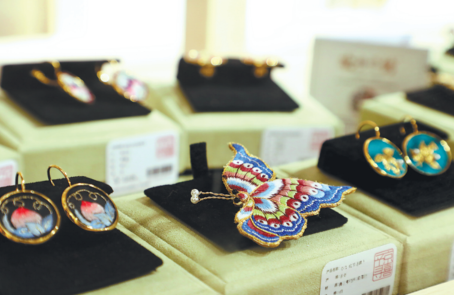Reshaping heritage gives buyers a sense of history
Fourth-generation practitioner shares ancient craft techniques that are evolving to attract younger generations, Yang Feiyue reports.

The morning sun shines through carved wooden screens, falling on the petals of a handcrafted peony taking shape under Li Yifan's deft fingers.
The flower is made from a stem of the medicinal tongcao plant (rice paper plant) by the same delicate art that once adorned Qin Dynasty (221-206 BC) court ladies, says the Beijing resident in her 40s.
The tradition continued for more than two millennia to the Qing Dynasty (1644-1912).
"I fix it onto modern hair accessories," says Li, as she coaxes delicate white fibers into fragile petals through meticulous pasting, folding, and pressing in the softly lit Yuxun Jingxi, a newly opened shop in the heart of Beijing's bustling Wangfujing area in late March.
A fourth-generation inheritor of this craft, Li says she is proud to revive the ancient art that few people recognize today.
Her ingenious maneuver has enabled the ancient art form to gain traction among an increasing number of contemporary consumers, especially younger generations.
"Before paper existed, our ancestors sliced this stem into sheets thinner than silk," she says as she holds up the sliced snow-white pith of the plant.
What makes the material extraordinary is its chameleon-like quality — translucent enough to mimic cherry blossoms when thinly worked, yet capable of layering into the plump curves of magnolias, she explains.
"They mimic real flowers: natural, biodegradable, and surprisingly durable," Li says with obvious admiration for the art.
"The whole production process makes zero waste, as the entire plant is utilized. We grind the scraps to make pigment with pollen," she notes, adding that the handmade technique hasn't changed throughout history.
Every step requires perfect balance. "Hand pressure must be perfect. Too firm and the material breaks; too gentle and you can't form the curves," she says.
"Interestingly, slightly sweaty hands help. Normally, we have just 20 seconds to shape a petal before drying or it won't hold its shape. But with natural hand moisture, we gain 40 precious seconds for detailing," she adds.
With the opening of Yuxun Jingxi, more products from her delicate touch — ranging from floral rings, brooches and table ornaments blending tongcao with modern elements — now gain new attention from the public.
The store was launched by Beijing Gongmei Group, a leader in China's arts and crafts industry, with a history of more than 70 years.
Focusing on integrating intangible cultural heritage and modern consumer needs, the store is designed as a cultural hub that combines intangible cultural heritage workshops, pop-up exhibitions, tea and coffee lounges, and retail.
This diverse mix of offerings is aimed at fostering dialogues between the legacy of traditional arts and the preferences of today's buyers.
"It is more than just a shop. It's a new commercial platform dedicated to intangible cultural heritage, art and innovation. While rooted in Beijing's rich history, Yuxun extends its reach nationwide, incorporating crafts and traditions across China. Every product in the store is intricately linked to traditional craftsmanship, forming a diverse and immersive experience," says Wang Jingjing, one of the initiators of Yuxun, a brand established in 2023.
Wang says Yuxun Jingxi is the first physical manifestation of the cultural brand and offers a multidimensional space that is "explorable and interactive".
The store showcases a variety of heritage techniques and products, with new additions constantly rotating, she adds.
"On any given day, visitors can witness live demonstrations from artisans, including practitioners of national, municipal, and regional-level intangible cultural heritage, ranging from traditional craft displays to large-scale installations," Wang says.
Next to Li's demonstration table, Weng Xiang, from a Beijing-based embroidery workshop, has bridged the ancient Jingxiu and modern fashion.
Jingxiu, also known as a palace or Beijing embroidery, originated in the capital city and flourished during the Ming (1368-1644) and Qing (1644-1911) dynasties as an exclusive craft for the imperial court, adorning royal robes, ceremonial objects and palace decorations.
"We carefully extract motifs from classical pieces of imperial embroidery, then reimagine them with modern aesthetics. For example, our gold-embroidered earrings and brooches are made from repurposed fragments of heritage patterns," Weng says.
At the shop, she presents items like a flying swallow pin, which was shaped first through traditional gold-wrapped thread embroidery — a luxurious Chinese needlework technique where real gold foil or gilded threads are meticulously coiled around silk strands — and then stitched the motif onto calfskin backing to create dimension.
"This transforms a museum-worthy technique into a lightweight, wearable pin. It's wildly popular because it turns heritage into something tangible and personal," Weng says.
The designer has worked with her team to research auspicious symbols and reinterpret them with contemporary relevance.
"Every piece carries forward ancestral craftsmanship while meeting modern demands for versatility and style," she says.
Her team has also used Chinese wordplay to create designs that resonate with younger generations, such as peach patterns for longevity and butterflies for arriving fortune.
The hurdles in the transition are technical and philosophical.
A single swallow requires 1-2 days of hand embroidery by masters with decades-long training, she says.
But the bigger leap was transforming 2D embroidery into 3D wearables. The team has experimented repeatedly to determine which backing materials to use to preserve luxury while ensuring comfort and how to scale craftsmanship without losing authenticity.
"Before, these stitches were behind glass. Now, when someone wears our swallow pin, they're not just accessorizing — they're keeping 600-year-old techniques alive through daily use. That's how tradition evolves to become relevant again," Weng says.
According to brand initiator Wang, while Yuxun initially operated as an online platform, the decision to establish a brick-and-mortar store was driven by the need to bridge the gap between digital browsing and tactile experience.
"Online, consumers were drawn to heritage-inspired creative products but often lacked the true sense of their textures, materials, and craftsmanship. The brick-and-mortar store solves this by offering hands-on interaction, allowing customers to appreciate the artistry up close," she says.
In the future, the shop's product selection will continuously adjust based on seasonal changes, consumer demand, and emerging trends.
"The exhibition area will frequently host different types of cultural showcases, from traditional craftsmanship to contemporary art, ensuring that the space remains a living, breathing testament to cultural evolution," Wang says.





Today's Top News
- Chinese FM urges Japan to reflect on, correct mistakes as soon as possible
- China hails 'hard-won' COP30 Global Mutirao decision
- Chinese premier urges G20 to uphold free trade, build open world economy
- China, US hold maritime safety talks in Hawaii as Beijing reiterates warnings on sovereignty
- China sends letter to UN over Japanese PM's remarks on Taiwan
- Chinese, Uzbek FMs hold second strategic dialogue






























